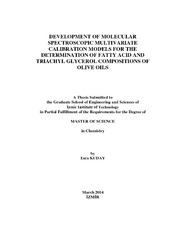Please use this identifier to cite or link to this item:
https://hdl.handle.net/11147/4232| Title: | Development of Molecular Spectroscopic Multivariate Calibration Models for the Determination of Fatty Acid and Triachyl Glycerol Compositions of Olive Oils | Other Titles: | Zeytin Yağlarının Yağ Asitleri ve Triaçil Gliserol Kompoziyonlarının Belirlenmesi için Moleküler Spektroskopik Çok Değişkenli Kalibrasyon Modellerinin Geliştirilmesi | Authors: | Kuday, Esra | Advisors: | Özdemir, Durmuş | Keywords: | Analytical chemistry Chemometry Olive oil Fatty acid Methyl esters |
Publisher: | Izmir Institute of Technology | Abstract: | The determination of fatty acid methyl esters and triachyl glycerol compositions of olive oils by chromatographic methods require not only sample pre treatment carried out but also extend the time of the analysis. Also, chromatographic methods are expensive. Therefore, there is a need for an alternative method. In this study, it is aimed to develop molecular spectroscopic multivariate calibration models for the determination of some of the fatty acid methyl esters and triachyl glycerol compositions of olive oils. For this purpose, 79 olive oil samples from different regions of Turkey (Manisa and Bursa) were collected and scanned with Fourier Transform Infrared spectroscopy equipped with attenuated total reflectance (FTIR-ATR) accessory, Fourier Transform Near Infrared spectroscopy (FTNIR) and Gas Chromatography (GC), High Performance Liquid Chromatography (HPLC). Chromatographic analyses of these samples were done by Olive Oil Research Institute and spectroscopic analyses were done by our group. The data obtained from High Performance Liquid Chromatography (HPLC) was chosen as a reference method for triachyl glycerol compositions and also the data obtained from Gas Chromatography (GC) was chosen as a reference method for fatty acid methyl esters. Also, Genetic inverse least squares (GILS) and Partial least square methods (PLS) were used for multivariate calibration. In conclusion, NIR and FTIR combined with multivariate calibration models can be more advantageous compare to chromatographic methods because of their simplicity and speed. When investigating the results, relatively successful calibration models were obtained from GILS method than PLS method. | Description: | Thesis (Master)--İzmir Institute of Technology, Chemistry, İzmir, 2014 Includes bibliographical references (leaves: 91-93) Text in English; Abstract: Turkish and English Full text release delayed at author's request until 2017.04.18 |
URI: | http://hdl.handle.net/11147/4232 |
| Appears in Collections: | Master Degree / Yüksek Lisans Tezleri |
Files in This Item:
| File | Description | Size | Format | |
|---|---|---|---|---|
| 10032489.pdf | MasterThesis | 4.34 MB | Adobe PDF |  View/Open |
CORE Recommender
Page view(s)
214
checked on Apr 28, 2025
Download(s)
96
checked on Apr 28, 2025
Google ScholarTM
Check
Items in GCRIS Repository are protected by copyright, with all rights reserved, unless otherwise indicated.